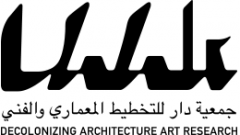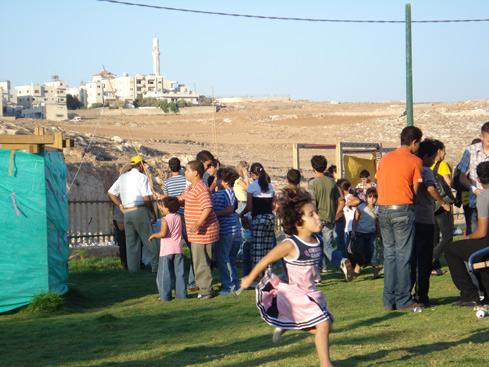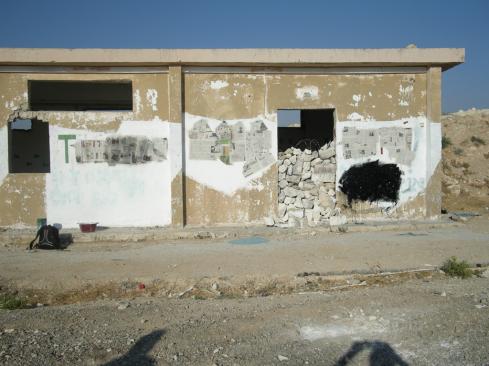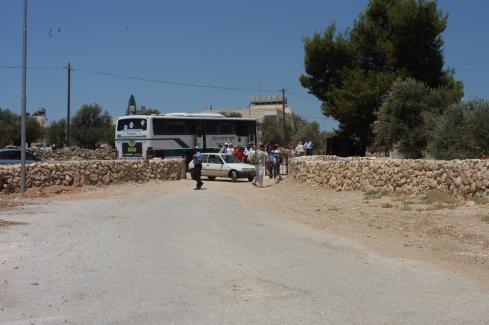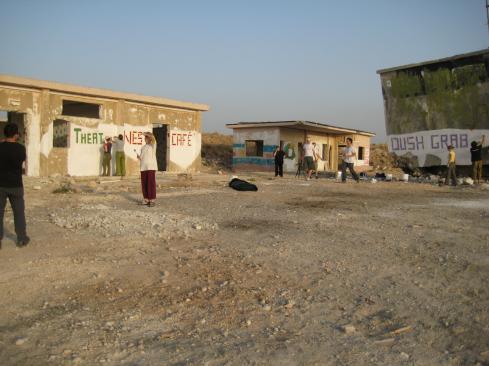In cooperation with the
28.02.2010 Kairos and Playground for Palestine CALL TO ACTION
Playground for Palestine is sending out this CALL TO ACTION to alert our supporters about a troubling development in the Oush Grab Peace Park, the site designated for a 2010 PfP playground installation.
The Israeli military is trying to implement a decision to confiscate community and privately held property belonging to the community and families in the Palestinian Christian town of Beit Sahour.
Included in this swath of land is the treasured Peace Park, which serves as a community space, park and recreational facility where Palestinian families gather daily and was to be the site of one of PfP’s next playgrounds.
We ask you to call and write to Israeli officials in order to protest this action, calling upon them to stop the construction of the watchtower, prevent settlers from attacking the park, and cease any idea of building a settlement in the site.
Follow the link and enter zip for to contact local congressmen – http://www.congress.org/communicate
Call the Israeli ambassador 202 364 5500 or email info@washington.mfa.gov.il
Email the Consulate General of the US, Jerusalem – uscongenjerusalem@state.gov
Call the Israeli consulate in Philly 215 977 7600
Contact the Assistant Secretary of the Bureau of Near East Affairs – Jeffrey D Feltman 202 647 7209
Injustice in Beit Sahour
A Statement by Kairos Palestine
(Jerusalem 20.03.2010) As described by town residents, Ha’aretz, Ma’an News, and other sources in recent days, Israeli soldiers and bulldozers arrived on February 10 at a family recreation park in Beit Sahour – a town slightly east of Bethlehem in the West Bank, and the site of the former army base Oush Grab, which was abandoned by the IDF in 2006 – and declared it a closed military zone.
KAIROS Palestine condemns this action and calls upon churches worldwide to advocate for the Christians and all residents of Beit Sahour and intervene in the damage, present and projected, wrought upon their home.
Please join KAIROS Palestine in condemning these oppressive actions in Beit Sahour and working to restore the justice that is both our calling and our right.
We ask you to call and write to Israeli officials in order to protest this action, call upon them to stop the construction of the watchtower, prevent settlers from attacking the park, and cease any idea of building a settlement in the site.
Please make appeals to:
[Ehud Barak] Minister of Defense, Ministry of Defense,
37 Kaplan Street, Hakirya, Tel Aviv 61909, Israel
Fax: +972 3 691 6940
Email: minister@mod.gov.il
Salutation: Dear Minister
Israeli Ambassador in your respective country
Copy to the:
Mayor of Beit Sahour
Email: bsmuni@p-ol.com
Kairos Palestine: www.kairospalestine.ps
Email: Kalimatuna@gmail.com
KAIROS Palestine is a group of Palestinian Christians who authored “A Moment of Truth” – Christian Palestinian’s word to the world about the occupation of Palestine, an expression of hope and faith in God, and a call for solidarity in ending over six decades of oppression – and published it in 2009.
From our board member, Nathan Dannison, more information at –
Here is a great background video re: the site:
and more background information from Decolonizing Architecture:
https://www.decolonizing.ps/site/?page_id=428
Here’s two articles regarding my non-violent protest and its result:
http://www.maannews.net/eng/ViewDetails.aspx?ID=204315
http://www.imemc.org/index.php?obj_id=53&story_id=56403
Here are my relevant blog entries:
http://michigantopalestine.blogspot.com/2008/08/praying-for-childrens-hospital.html
http://michigantopalestine.blogspot.com/2008/08/ush-ghrab-is-safe-again.html
Here is some troubling information regarding the current state of affairs:
http://michigantopalestine.blogspot.com/2008/08/ush-ghrab-is-safe-again.html
Also –
Beit Sahour: a new struggle by Ben White – 21 February 2010 11:49, The Newstatesman
http://www.newstatesman.com/blogs/the-staggers/2010/02/palestinian-israeli-settlers
21.02.2010 Protest march in Oush Grab
Tens of people gathered in Oush Grab to protest against the military presence in the area. Town’s people and internationals were peacefully marching towards Oush Grab hill when a Israeli army jeep, soon followed by another 6 or 7 swooped on the demonstrators, among which there were elderly and children. After barking orders in Hebrew, one of the soldiers began to throw tear gas and “sound bombs”, momentarily dispersing part of the crowd.
The organizers of the march have called for another march next Sunday.



15.02.2010 Olive trees planted on the Oush Grab hill. Israeli army’s work continues.
Some 150 activists, Palestinians and internationals gathered in the morning of Thursday the 11th of February around Oush Grab hill to plant hundreds of olive trees.
The privately owned fields surrounding the old military compound were planted to ward off the threat of land confiscation in the area recently declared a closed military area again.
Over the following days work on the top of the hill has continued. The watchtower on the side of the hill was demolished but most of the old military structures are still standing. A portion of the the earth mound on the top of the hill has been levelled.
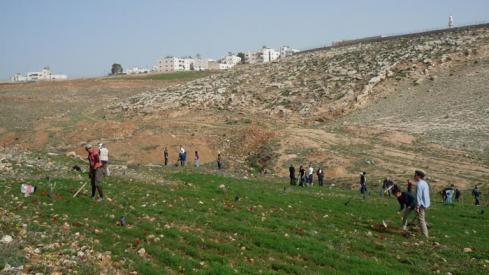
10.02.2010 Israeli army bulldozes Oush Grab area
On Wednesday, the 10th of February, Israeli soldiers and police entered the park compound in Oush Grab and began levelling ground and destroying old military outpost structures with two bulldozers. An area much larger than the old military base was declared a closed military zone and access was prohibited to land owners and journalists.
The family park, part of the old military compound converted into a playground, climbing wall and barbecue area with funds from international donors including USAID, has not been damaged so far and works have concentrated on the top of the hill.
More from Ma’an news here and here.


01.02.2010 Israeli army to reoccupy base near Bethlehem
http://www.maannews.net/eng/ViewDetails.aspx?ID=258146
– Ma’an – Israel’s army plans to reoccupy an abandoned military base near Bethlehem, security sources said on Sunday, in a move certain to please settlers seeking to establish themselves in the district.
An Israeli military spokeswoman told Ma’an that the army will rebuild parts of a base in Beit Sahour known as Oush Al-Ghrab “in order to ensure security in the area, according to all of the estimates of officials in the IDF [Israel Defense Forces].”
On Friday, activists aligned with the right-wing settler groups Women in Green and the Committee for Jewish Shdema were in the area for a tree-planting ceremony, part of their weekly efforts to prevent Oush Al-Ghrab “from falling into Arab hands”, the settler-affiliated Arutz Sheva news agency reported. Before the ceremony they marched to the site which they call Shdema from the Har Homa settlement, also in Bethlehem.
“Placing an outpost at Shdema is a sign that Shdema will, with G-d’s help, become a thriving community – and this is happening thanks to the determined and unflagging activity of the Council for a Jewish Shdema,” said Gush Etzion settlement leader Shaul Goldstein, according to the news agency.
“The Council for a Jewish Shdema has succeeded in its mission and it can now continue and become the ‘Council for a Jewish Jenin’ or ‘for a Jewish Shechem [Nablus]’,” he reportedly added, “half-jokingly.”
Oush Al-Ghrab is a former Jordanian military base that was taken over by Israel during its 1967 occupation of the West Bank, Gaza Strip, and East Jerusalem. Israel’s military evacuated the post in April 2006. After the evacuation, the Israeli authorities allowed the Beit Sahour municipality, with support from the US Agency for International Development, to build a park, which has become a popular destination for local Palestinians.
Beit Sahour Mayor Hani Al-Hayek told Ma’an that “the Israeli occupation forces say they withdrew from the base in April 2006, but they didn’t leave it completely. Settlers, on an ongoing basis, go there every Friday.”
Al-Hayek added, however, that he doubted the army would actually follow through with the plan. “If they intend to reoccupy it, as in the past, this would harm the peace process and further divide the two parties, as well as inflame public opinion” against negotiations with Israel, he said.
According to the mayor’s legal advisor, Farid Al-Atrash, “This plan constitutes a violation of international law and the Geneva Conventions, which prohibit moving populations into occupied territory. It is also a violation of signed agreements with the [Palestinian] Authority.”
In addition to the park on the slope just below the base, the area is designated for further development. In December 2007, the American Christian group CURE International announced it would donate 16 million US dollars to build a hospital on the hillside. In total, 65 dunams (65,000 square meters) have been designated for the hospital and other development, except for the hilltop, the location of the abandoned base.
In May 2008, however, settler groups began to arrive at the base. The settlers have organized a series of visits on Fridays, culminating in late 2008 in a tour titled “Shdema – a Jewish City.” Dozens of Israeli settlers, some of them armed, took over the abandoned base for several hours the same month.
According to the Committee for Jewish Shdema, in a statement, “Two targets have been met thus far.” “Ensuring that the land is not transferred to Arabs and maintaining a Jewish presence there.”
Oush Al-Ghrab is in Area C, designated by the Oslo Interim Agreement to be under full Israeli control until a final peace agreement compels Israel to withdraw completely from the West Bank.
26.01.2010 Israeli settlers groups vandalized Oush Grab Park

On 15 January 2010, a group of settlers entered Oush Grab and vandalized the public park, spray-painting David stars all over it. The settler attack came after a group of “leftist activists and Christian anarchists”- as some settler associations report in their website www.yeshabulletin.com “spray painted the walls of the buildings where settlers plan to establish the colony of Shdema with verses from the Bible and slogans of ‘love and peace‘. The Committee for Jewish Shedma and the group Women in Green – both of them settlement organizations – wrote in their website that “Shdema activists went down to the illegal compound that the Arabs built at the foot of Shdema, in Area C. They went in and sprayed all of the Arab illegal buildings, inside and out, on the walls, on the doors and on the floors.”
On 22 January in the morning, settlers gathered near Oush Grab. A group of less than 10 international activists came to the park of Oush Grab to take some pictures of the graffiti spray-painted by the settlers and to monitor the situation. A group of soldiers were on the top of the hill. Settlers didn’t come to the public park.

23 08 2009 West Bank: slowly, determinedly, settlers bid to build new town
by Rory McCarthy
The Guardian, http://www.guardian.co.uk/world/2009/aug/23/west-bank-israeli-settlements
In the first of a series of exclusive reports examining settlements in the West Bank and their role in the middle east peace process, Rory McCarthy meets a group of Israelis who want to ‘redeem’ a patch of land near the Palestinian town of Beit Sahour.
Early in the morning, Nadia Matar drove to the hills south of Jerusalem, near the Palestinian town of Beit Sahour, and turned into a dusty, unmarked road. There she planted a sign which read “Welcome to Shdema”. She drove on, stopping every few metres along the route to jam into the rocky ground a series of fluttering blue and white Israeli flags. Israeli soldiers let her pass unhindered as she drove up to the concrete ruins of what was until a few years ago the Israeli military base of Shdema.
Here, just a stone’s throw from Palestinian homes and only a few minutes from the city of Bethlehem, Matar and her friends are intent on building a Jewish community, the next settlement outpost in the occupied West Bank.
It is a glaring challenge to the Obama administration, which is trying to halt all Israeli settlement growth as a precursor to renewed peace talks. But recent history suggests it is the highly-motivated settlers like Matar, 43, a mother of six born in Belgium and now living in the settlement of Efrat, who may in the end triumph on this particular dusty patch of land.
Tomorrow, the Israeli prime minister Binyamin Netanyahu arrives in London for a series of key meetings, including four hours of discussions on Wednesday with the White House’s special envoy, George Mitchell, and talks with Gordon Brown tomorrow. The continued colonisation of the West Bank, an extraordinarily successful project over the past 40 years, will dominate the agenda. Settlement on occupied land is regarded as illegal by the rest of the international community, but nearly 500,000 Jewish settlers live in east Jerusalem and the West Bank. Shdema is even beyond Israel’s West Bank barrier, which runs deep into Palestinian territory and which many believe will one day be the final border of Israel.
Matar’s goal is “redemption of the land”. In her view, the land on which the Palestinian homes sit belongs by Biblical and historical right to the Jewish people and is, for now, “temporarily under Arab occupation”. She is trying to build a “Jewish Shdema” and to prevent the land from remaining Palestinian. After the military evacuated the base there were plans, since shelved, to build a hospital for Palestinians. “They want more pieces of land that belong to the Jews. They want to take it away from us,” Matar said.
“The Land of Israel was given by God to the people of Israel,” she said. “Some will tell you God gave it to us, others will say Jewish history of 4,000 years is our historical right … You don’t have to be a religious Englishman to see London belongs to the British.” This is a rare insight into how outposts get built: with determined settlers and eventually complicit Israeli authorities.
At first, after the army withdrew from the base three years ago, soldiers closed the area off and prevented all settlers from approaching. But the settlers sneaked in and kept coming. Eventually Matar, a leader of the group Women in Green, and her supporters convinced the military to allow them in just once a week, on a Friday. They cleaned the buildings up, painted over graffiti, tidied the rooms and held workshops and discussions. Sometimes they have stayed the night, sometimes they have been allowed to come twice a week and eventually, they believe, settlers will begin to live here.
Similar struggles take place every week on other hilltops across the West Bank. All this is happening even though the Israeli government says in public it will allow no new settlements.
“At the beginning we fought against the army to come up here,” said Matar. “But when they saw we were adamant they let us come on a Friday … But it’s not enough for us. We don’t want to ask permission to be in our homeland.”
Now every time they come the army far from preventing them in fact provides them with security, deploying several soldiers and armoured vehicles but not interfering with their activities. In April the military also halted the construction of a Palestinian park, part funded by the US government, because it was at the foot of the hill claimed by the settlers at Shdema.
Already the settlers have produced a glossy brochure with architectural plans of the Shdema they would like to see: it has grassy lawns, lines of trees, a cultural centre and a small but thriving Jewish community.
On this day around 30 settlers of different ages gathered, among them several children, a rabbi and at least two women carrying discreetly holstered pistols. They sat in one room on plastic chairs as Tomer Karazi, 34, a rabbi with five children, discussed a Biblical text and the importance of building a new village in this Biblical land.
Later Karazi said he and his wife Hannah were ready to move from their home in the settlement of Nokdim to Shdema as soon as possible. “It’s our duty not to escort the process of redemption from the outside but to be involved and active from the inside,” he said. “We don’t need to wait for things like water and electricity. And we really love the place. It’s beautiful.”
Then out came large tubs of white emulsion paint and several brushes and the group began painting over the grey concrete walls, stopping occasionally for glasses of water and slices of watermelon.
Yosef Ziggerman, 18, a settler from Efrat had been involved in several other, often unsuccessful, attempts to establish new outposts on nearby hills. “I believe every single piece is ours and I don’t see many pieces of land as beautiful as this,” he said. “We aren’t doing anything crazy or fanatic. We’re painting and making it look nice.”
Several spoke of their frustration with other Israelis who enjoy the more secular lifestyle of cities like Tel Aviv or Eilat but who seemed not to understand or endorse the settlers’ millenarian ideology and their effort to claim the West Bank as their own. Since Israel withdrew its settlers from Gaza four years ago, many fear more compromises and would rather take a more radical and practical stand to expand Jewish settlement of the West Bank.
They described themselves as a frontline in a wider struggle against what they see as radical Islam, insisting that settler outposts protect the larger settlement blocs, which in turn protect Tel Aviv and Jerusalem, and which in turn protect the Western world.
“People like to present us like crazy lunatics,” said Matar. “But one day these people in the West will see. The Muslims are taking over there too. You better be on our side for your sake, but you guys in Europe are not. Those who curse Israel will be cursed, and those who bless Israel will be blessed.”
09.04.2009: Palestinians opposing Jewish settlement in Ush Ghrab have shown courage but their efforts are futile without support
by Ben White
The Guardian, http://www.guardian.co.uk/commentisfree/2009/apr/07/israel-ush-ghrab
The flat top of the small hill is deserted, as we walk among the gutted concrete buildings. The graffiti on the wall declares that “the Jews will keep this land”. This is Ush Ghrab, a small piece of land in Beit Sahour, south of Jerusalem, and a target for religious settlers seeking yet another colony in the Bethlehem region.
I was walking around the site with my friend Saleem and his colleague Jason, who both work for Paidia, an NGO focused on educational play. Their work has been, and continues to be primarily social, yet they are now forced to join other locals in defending the site from attempts at colonization.
For decades, this piece of land was used as a military base, first by the Jordanians and then by the Israelis. In 2006 the Israeli army closed down the base, and the land reverted back to the Beit Sahour municipality, which in co-operation with NGOs proceeded with plans for the development of the site.
In May 2008, on Israel’s 60th anniversary, Jewish settlers turned up one morning, and announced their intention to create a new settlement on Ush Ghrab. Ever since, rightwing groups such as Women in Green, have been holding events on the hill as part of their open drive to get the land back to its “rightful owners” – the Jewish people.
Suhail Khalilieh heads the Settlements Monitoring Department at the Applied Research Institute – Jerusalem (ARIJ). “What usually happens is that when the military leaves a certain location, the settlers come and take over and start developing,” he explains. “The settlers decided to take over the location basically because of the bypass road opened near Ush al Ghrab, connecting several settlement locations, south-east of Bethlehem. This road made it easier for the settlers to access Jerusalem. While they are thinking about developing Ush al Ghrab into a whole new settlement, right now, they are simply trying to take control of the land area.”
In parallel to these efforts by settlers, there has also been a huge variety of events held on Ush Ghrab organised by an informal grouping of Palestinian activists in Beit Sahour and Bethlehem. These have included barbeques, bingo, kite flying, bird-watching, music, tree-planting, ecumenical religious services and leadership training activities.
In recent months, however, Ush Ghrab has been quieter. The winter slowed things down, and local activists also decided to give the municipality some time to pursue a more “official” track with the Israeli authorities. Apparently, the Beit Sahour municipality had expressed its displeasure with an intense level of events on the land, arguing that such activities merely provoke the settlers and attract unwelcome attention.
Those like Mazim Qumsiyeh, a professor, author and Beit Sahour resident, disagree with this assessment because “in our humble opinion the settlers are driven by their own agenda and aren’t driven by what Palestinians do or don’t do”. Qumsiyeh believes that “pressure works”, and points to places such as Bil’in and Ni’lin where activism has “slowed down” Israeli colonisation and brought about some changes in the path of the wall: “There have been no Supreme Court interventions in other cases where villages didn’t offer resistance, or weekly demonstrations.”
Yet Qumsiyeh is also well aware of how the struggle in Beit Sahour is ultimately part of a bigger picture: “If the agreement between Nentanyahu and Lieberman is as stated in the newspapers, the Israeli government is going to focus on developing E1 [an area of the West Bank]. This is pure speculation, but maybe this buys us a couple of years here. The Israeli government won’t want to receive the flak for too many things at the same time.”
The hard reality for the Palestinians of Beit Sahour is that, alone, they are unable to resist the theft of their land, should the Israeli government support the settlers’ initiative. Khalilieh, whose job at ARIJ means he oversees the daily documentation of Israeli colonisation, says that while the Beit Sahour residents’ protests “send a message”, they are “probably useless” without international pressure.
This sense that without outside intervention resisting yet more colonisation in the West Bank is unlikely to produce results is sharpened by the fact that it can be hard to engage local Palestinians in popular resistance en masse. Jason and Saleem say that the larger events held on Ush al Ghrab have seen a couple of hundred participate, but the activism is essentially “driven by a very small group”.
One of the factors for the Palestinians feeling that it is “hopeless” is the way the Oslo Accords and Palestinian Authority have developed since the 1990s. Qumsiyeh believes that in some respects this “killed activism” on the ground: “Most people I talk to are demoralised. They think the PA is corrupt, that there is collaboration at the highest level, so they ask, ‘Why should I put my neck on the line as an individual?'”
Ultimately, no one in Beit Sahour can tell what the future will hold for Ush al Ghrab. Will the settlers be emboldened by a rightwing Israeli government offering tacit support? Or will Netanyahu’s cabinet prefer to focus on home demolitions in Jerusalem and developing E1? One thing is for sure: on the ground resistance can only work in tandem with the kind of international pressure on Israel that is still a distant prospect.
16.10.08: Non-violence meets 6 Violent Arrests
On this day we had plans for a hike with bird-watching (Palestine Wildlife Society), music festivities, and athletics. We arrived at 11 AM and our first attempt was to take three barrels (one for regular trash, one for glass/plastic, and one for compost) to put at the place where the settlers are to gather. Dozens of heavily armed soldiers blocked our way. We asked to see the military order of closure and they showed us an order that said that the area is a closed military zone (ironic since colonial settlers were allowed to get in with no problems!). Some soldiers took over a private home near the site and imprisoned its owners in one room while they made it into a military post with roof and window guns pointed at us.
We asked the soldiers to at least please deliver the trash barrels/bins to the site because every time settlers come they leave trash everywhere. We educated the soldiers and police (or at least those of them who listened). The soldiers followed us on the hike around the mountain and it was when we came close to the road which settlers used to get up the hill that they became insistent on us leaving. As we were walking back, an international friend was suddenly attacked from behind and others were also attacked and kidnapped. We were told that if we go back to the park area and stay there they might be released. So essentially, the friends were hostages to impact our decisions (this is considered a war crime and fits the definition of terrorism to try and coerce an action from someone by threats to harm a friend or relative). We went ahead with our other activities (including over 70 children who had a rap and other music festival) while negotiations for the release of our friends ensued and expanded to include the Mayor and officers of the Occupation army. Finally after several hours five of our comrades were released but one was still being held and may be deported. The five released included two Palestinians (one from Beit Jala and one from Bethlehem) and nationals from Italy, England and the US. After the army withdrew, we noticed that the soldiers (but not the colonial settlers) used our trash containers but had decided to also add a few rocks! The colonial settlers plan to return with their hateful messages (and trash) on 9 November.
Please follow this link for another account of a participant.
Video accounts of the event: part 1 and part 2
Women in Green (settler movement) account of the event.

9.09.08: Prime Minister Salam Fayyad inaugurated the Oush Grab Public Park
On Tuesday the Prime Minister Salam Fayyad came down to the site of the newly built Public Park at Oush Grab to inaugurate it.
27.08.08: Members of the Knesset visit Oush Grab
On Wednesday a number of MK’s visited the site as was earlier announced in an article by the Jerusalem Post. Unfortunately this article was speaking of a proposed park and children’s hospital, while the park has long been finished and is in use by the people of Beit Sahour. A second article of the Jerusalem Post that followed the MK’s visit was as biased as the first since it did not even mention the interview it had with Paidia at the site that afternoon. The title of the article alone ‘MKs: Say no to Palestinian Hospital in Gush’ foregoes the known fact that the military base of Oush Grab is built on Palestinian Land that in no way belongs to the Gush Etzion settlement.
22.08.08: Settlers at Oush Grab
We did not realize it until it was already quite late that there were settlers at Oush Grab. When we arrived to monitor the situation and have internationals present in the Public Park there were at least two jeeps standing in front of the dirt road up to the hilltop. The soldiers said that the settlers were leaving and according to an Israel National News article published late last night the police forcefully evacuated the settlers from the site.
15.08.08 & 16.08.08: Paidia Summer Carnaval
Hundreds of children enjoyed numerous games and races at the climbing tower at a two-day carnival at the Public Park.
10.08.08: Soldiers Prevent Settlers From Moving Up the Hill
People who were already present at the Public Park witnessed that four jeeps were blocking the entrance and did not allow the gathered settlers to move up the hill.
6.08.08: Prayer Session at Oush Grab
Approximately 25 internationals and Palestinians gathered on top of the hill for a special prayer session. Even though it was led by a Christian Protestant priest and pastor the service was intended for all religions and those who do not adhere to a specific religion but do believe in being present to send a message and call for justice and peace. As the service started five or six settlers were already present at the other half of hilltop to set up lights and chairs for their lecture series of the evening: ‘From Destruction to Redemption in Shdema’. Soldiers were witnessing the event from a side at the top of the hill.
As time passed more and more settlers arrived and gathered at the left half of the hill while we were having the service on the right half. At about 6.45 pm a hundred settlers had arrived, the Israeli flag was hoisted on the cistern, and they set out to start their lectures, while children were spraying graffiti and waiving the Israeli and settler flags. At the end of our service we remained singing, praying and meditating for peace.
At a certain point the soldiers came down from the top of the hill and lined up in between us and the settlers. The situation obviously grew more tense. Young settler boys were allowed to walk in between us, curse at us and wave their flags in front of our faces, but we continued singing. More and more settlers approached the line of soldiers and in an instant the situation seemed to burst. They easily broke through the lines and started to physically push us out, a number of us were hit by stones, were spit at in the face and the minister was actually dragged over the ground by a settler while he was still praying. Eventually, we were pushed into a corner of the hillside and the soldiers managed to form a new line-up between us and the settlers. We decided to stay, a small prayer was held as we formed a circle and after this we continued to make music and sing.
Some settlers tried to come through the soldiers line-up and one boy told us that if a children’s hospital would ever be built he would bomb it. We continued to sing but were silent at times that the settlers seemed to pray out of respect for their religious views and a common humanity that was hard to imagine at the time. At About 9.30-9.45 the settlers cleared out and after this we too left the top of the hill.
Israel National News article announcement of the Jewish March up to Shdema.
IMEMC coverage of the events.
 Photo Credit: Maan News Agency
Photo Credit: Maan News Agency
5.08.08: AIC Women’s Group
The co-director of LifeSource and the permaculture farm Bustan Qaraqa is an expert in water related issues and is giving a lecture to the AIC Women’s Group at Oush Grab. The lecture touches upon the Israeli water policy, how this impacts the water situation in Palestine and the women’s daily life. Furthermore the women get to learn and see the importance of the Oush Grab pumping station and the danger of the open sewage pollution.
31.07.08: Two Busloads of Settlers at Oush Grab
The mayor informed us that two busloads of settlers arrived at Oush Grab in the morning and left at about 11 am.
30.07.08: Creating the Oush Grab Mall
While about thirty of us were painting the new ‘Oush Grab Mall’ with a bookstore and Grab Falafel a car pulled up between the structures, took one look at us and left. At 18.00 pm when we were wrapping up our paintings after covering all the buildings a group of approximately 60 settlers appeared. Mainly they were young teenagers but soon were followed by men, women and children. We continued finishing the last paintings and cleaning the brushes but the settlers encroached upon us, screaming that we had to leave. In response to their clearly aggressive attitude we decided to leave in order to avoid any confrontation. In the meantime more and more settlers were arriving and soldiers observed from the top of the hill on the side.
The commander told me that he would clear the settlers out in an hour because this was now a restricted area for all. We moved down to the road, but after an hour and no sign of any settlers leaving or soldiers attempting to get them to leave we talked to the soldiers again. They told us that they had ‘trouble’ moving the settlers out but that we had to move into the park to avoid confrontation. Meanwhile settler kids were roaming on the road and walking in between the jeeps, up and down the hill. Eventually, we had to move into the park and two of us went up to talk to the soldiers again. They told us that they had no order to clear the settlers out and that they could stay for now but that they were leaving, ‘maybe tomorrow’.
At approximately 01.00 in the night there were no people left in the Public Park and we decided too leave to as there was no use in us staying. One jeep with soldiers was left and they told us that there were still about 100 settlers on top of the hill.
Settler Blog account (copied from the Women in Green Newsletter) of the Youth March up to Shdema.
Apart from these events an article was published about the situation and ‘the struggle for settlement continuity’ in Haaretz.
26.07.08: Louisa Morgantini, Vice-President of the European Parliament, Visits Oush Grab
Louisa Morgantini, the vice-president of the European Parliament has shown a great interest in Oush Grab since 2002 when it was still a military base. At this visit Mrs. Morgantini and the 40 people strong delegation of civil society members attended a series of lectures about the current situation and the chosen strategy. The political, architectural, social and natural aspects were emphasized by Dr. George Rishmawi from the Beit Sahour Municipality, Decolonizing Architecture, Paidia, the Palestine Wildlife Society and the Alternative Information Center. Thereafter Louisa Morgantini and her delegation of civil society members visited Oush Grab to see the site and the racist graffiti that cover the structures inside and out.
25.07.08: Settlers move up the hill, internationals are removed and press is not allowed.
On Friday morning two internationals were at the top of the hill at the military base just to monitor what was happening. As they were about to leave a military jeep and two buses pulled up. About 40 settlers and two reserve soldiers made their way up the hill. The settlers started spray-painting and videotaping, screaming ‘anarchists’ at the internationals. In the meantime more settlers and soldiers arrived.
The soldiers asked the two internationals what their purpose was and they replied that they would not leave if the settlers did not have to leave too. In the meantime press, Palestinians and internationals arrived but were not allowed to climb the hill. Eventually the army issued the order that the whole area was a restricted area for all. First the internationals on the top of the hill were asked to leave, which they did in exchange for the guarantee that the settlers would also be removed. After about an hour the soldiers also managed to remove the settlers from the site. When the settlers were gone the gathered Palestinians and internationals returned to the hilltop and unsurprisingly found racist graffiti covering all the structures and an Israeli flag waving in the wind. It did not take long to take the flag down again.
 Settlers on the top of the hill of Oush Grab
Settlers on the top of the hill of Oush Grab
 Press is not allowed to cover the situation
Press is not allowed to cover the situation
 Taking down the Israeli flag after the settlers have left
Taking down the Israeli flag after the settlers have left
20.07.08, 21.07.08 & 22.07.08: Small Groups of Settlers Scout the Hilltop
Small groups of approximately 5 settlers each time appeared on the top of the hill in the mornings.
14.07.08: Loud Party Against Settler Sleepover
Settlers had stated their intention to spend the night at Oush Grab and they arrived monday evening around 7.00 with approximately 150 people. A number of them were heavily armed with rifles and smaller guns and amongst the settlers there were very young children.
In response, a ‘loud’ party was organized in order to make the settlers intended sleepover as sleepless as possible. Bright lights from the park would be directed at the top of the hill and after the end of the local Fakouz festival at 22.00 pm the DJ would move up to the top of the park with the speakers turned up and directed at the hilltop. In this way a large crowd would enjoy the music and clearly signal that this place is in use by the Beit Sahour community and that settlers are not welcome. Any direct confrontation was to be avoided; that is why the gate to the Public Park was closed and guarded and no alcohol could be sold.
Unfortunately and for unforeseen reasons, the municipality could not continue its support for the plan and forbid the use of loud noise in order not to bother the neighbours. A small group of Palestinians and internationals stayed for the whole night to monitor the settlers’ behavior. At 6.00 the next morning the last 8 settlers voluntarily left the hilltop. During the night the handful of soldiers merely went up the hill with the settlers and blocked the road, solely allowing people to go home. For most of the night only two soldiers were present in the jeep stationed on the road. Due to the presence of the settlers the first days of the Paidia summer camp for children had to be cancelled.

 Armed settlers move up the hill . Photo Credit: Left> Active Stills Right>IMEMC
Armed settlers move up the hill . Photo Credit: Left> Active Stills Right>IMEMC
 Settlers hoist the flag. Photo Credit: ActiveStills
Settlers hoist the flag. Photo Credit: ActiveStills
 Settlers prepare to settle in for the night. Photo Credit: IMEMC
Settlers prepare to settle in for the night. Photo Credit: IMEMC
 Meanwhile the Local Fakouz Festival and Loud Party are in full swing at the Public Park. Photo Credit: IMEMC
Meanwhile the Local Fakouz Festival and Loud Party are in full swing at the Public Park. Photo Credit: IMEMC
13.07.08: Papier-Mache Oush Grab
In the afternoon Palestinians and internationals gathered to respond to the newest wave of racist graffiti. This time the creative response is not only painting over the buildings but papier-macheeing the walls and graffiti with newspapers. The mixture with which they were pasted on the buildings of flour and water also included sugar. The sugar and juice that was sprinkled in the buildings was intended to later attract mosquitoes in order to make the settlers planned sleepover unpleasant.
11.07.08: Settlers take the Hilltop while Palestinians and Internationals are prohibited from moving up
At 10.00 50-60 Palestinians and internationals gathered at the Public Park as settlers had announced to come to Oush Grab and spend the night on Monday. The army had already blocked the road to the way up the hill but when asked, it granted permission to the group to move up the hill and see the graffiti that had been done for 10 minutes.
At about 10.30-11.00 approximately 60 settlers arrived and the Israeli army escorted the settlers up the hill. The 50 to 60 internationals present at the public park went to the roadblock and asked for an explanation. The soldiers answered that the settlers had permission to be up the hill. After about three hours the settlers left without any pressure by the military. Again, we found the military structures covered in racist graffiti.
 While settlers are up the hill, Palestinians and internationals are held behind an army roadblock. Photo Credit: IMEMC
While settlers are up the hill, Palestinians and internationals are held behind an army roadblock. Photo Credit: IMEMC
 Settler Graffiti: “Arabs” with a cross through it
Settler Graffiti: “Arabs” with a cross through it
13.06.08: Oush Grab Grand Tour
Four NGOs and the Beit Sahour Municipality organized the Oush Grab Grand Tour in order to inform people about the area, its history, importance and purpose. The day started out with introductory talks. The AIC spoke about the political importance of the site and Paidia informed the people present of the social function of the park and environment. The Palestine Wildlife Society emphasized the importance of the flora and fauna in the area and Decolonizing Architecture spoke about alternative ways to find new meanings for the structures of occupation such as the old military base on the top of the hill. After this, the group moved on to tour the area, see the old military structures and make an alternative tour path with materials from the environment. Unfortunately, two soldiers appeared to the scene and ordered us to stop the activities even though they were purely environmentally and disturbing nobody.


 Releasing a snake back into the wild during the Oush Grab Grand Tour
Releasing a snake back into the wild during the Oush Grab Grand Tour
6.06.08: Bingo at Oush Grab Plaza
About 40 to 50 Palestinians and internationals gathered to play bingo at Oush Grab. The military watchtower on top of the hill is turned into the till were participants can pay their 2 Shekel entrance fee. Anyone can join and if settlers would have shown up they would be invited to join the activity as long as they paid the entrance fee. While participants were playing bingo and winning prizes down at the base three soldiers arrived. At the question what we were doing there was no other answer than: playing bingo. The soldiers seemed highly confused and uncomfortable with reporting a bingo game to their commander. In the end the soldiers never asked us to leave but the mayor informed us that we had better go.


 Soldiers observe the Bingo game
Soldiers observe the Bingo game
4.06.08: Creating Oush Grab Plaza
Palestinians and internationals arrive at Oush Grab to paint ‘Oush Grab Plaza’ with its own ‘Theater’ and ‘Nestcafe’. The settlers graffiti is being covered by friendly non-political paintings in the afternoon paint session.

 Before and After
Before and After


Before and After

 Before and After
Before and After
30.05.08: Settlers at the Hilltop
Approximately 40 settlers came to Oush Grab. A number of them came down to the base to spray graffiti over the paintings that were made earlier. One of them spoke to Jason from Paidia and told him that they were planning to establish a new settlement here because they had heard that the Beit Sahour Municipality had construction plans for the site. Jason replied that they did, in order to build a new children’s hospital and asked isn’t that a good thing?
The settler replied: Yes, for Arab children but we do not want a hospital for Arab children here. They should build it elsewhere, in Jordan for example, where all Arabs should live”.
Another settler spoke to Ala and said that the Palestinians teach their children in school to hate Jews and drive them into the sea. She said that she had read this herself in Palestinian school books. When Ala asked her if she spoke Arabic she replied that she could only read it.
23.05.08: Paidia Game Day
Fourty settlers were up on the hill when about ten people arrived for the Paidia Educational Games Day at Oush Grab. They gathered at the climbing tower and than went up to the hill to play their games. The group played games and said ‘good morning’ as they passed the settlers, who were initially confused and wondered whether they were tourists who had just greeted them. When they realized that the people playing the games were not tourists they started making phone calls. Not long after the army arrived and seemed confused too, but told the people who were playing the games that they had to leave in 5 minutes. The game-players pretended that their next game was at the climbing tower so that they had to leave anyway and left.
 Settlers watching in the background while the Paidia Game Day is in progress
Settlers watching in the background while the Paidia Game Day is in progress
20.05.08: AICafe on location at Oush Grab
The AICafe is held on location at Oush Grab in order to draw broader attention to the issue. In addition Nassar Ibrahim, the co-director of the Alternative Information Center (AIC) gives a lecture about the history and current situation in Lebanon and its effects on the Middle Eastern region.
19.05.08: Picnic at Oush Grab
To show our presence on the hilltop there is a picnic at Oush Grab.
18.05.08: Creating Hotel Oush Grab
Decolonizing Architecture artists in residency Brave New Alps started removing the Zionist writings and the flag left behind by the settlers and together with Anne Gough and Jesse Long they created Hotel Oush Grab. Members from the AIC cleaned the site in preparation for the upcoming Paidia Game Day.
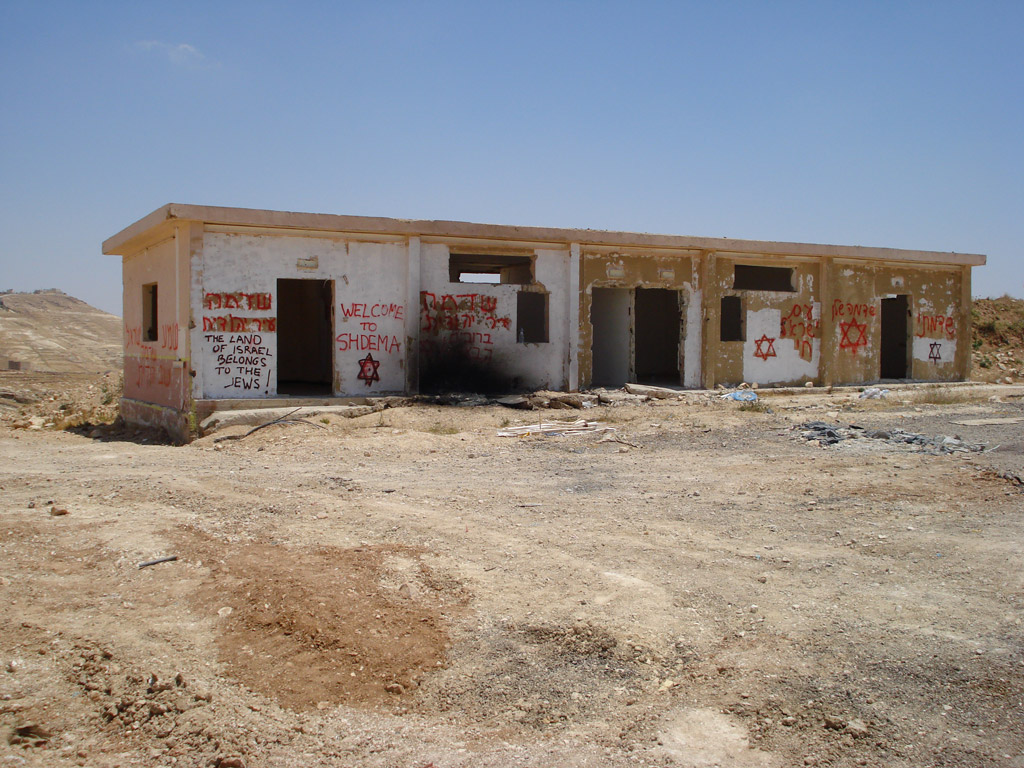



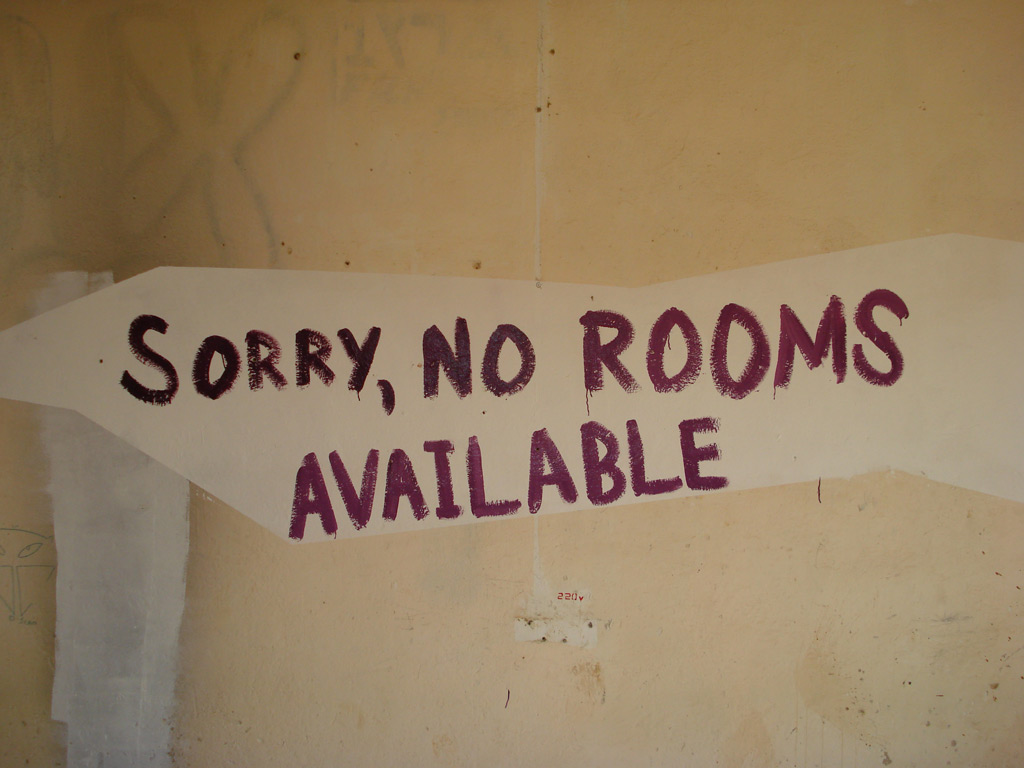
16.05.08 & 17.05.08: Settlers Show Up Again
The settlers showed up on the top of the hill of Oush Grab on the two following days.
15.05.08: Nakba Day
The first arrival of 40 settlers at Oush Grab who claimed they wanted to establish a new Jewish settlement named ‘Shdema’ during US president George W. Bush’s visit as a response to US pressure on the Israeli government to stop building in ‘Judea and Samaria’.
An article by the Israel National News clearly states the settler’s intentions:
The groups emphasize that the struggle here is not only for Shdema per se but against the entire Olmert-Livni policy of building cities for the Arab enemy while freezing Jewish building.
Women in Green head Nadia Matar pointed out that the settlement of Shdema constitutes a new method of operation for Land of Israel activists. “Until Gush Katif, the national camp used to always react – to be passive,” she told Arutz Sheva. “We used to wait till the day of the expulsion came to actually start doing something and getting organized. Now we understand that that is not the way. We must initiate. We must be active and lead the way. Whether it is building new outposts all over Yesha (Judea, Samaria and Gaza). We must not wait till it is too late, wait untill the bulldozers come in August to destroy the community of Migron, but rather launch the struggle already now.
Women in Green is heading what they call ‘the battle for a Jewish Shdema’.
An account of the First arrival of the settlers on YouTube.
News episode on the settlers first arrival on YouTube.
